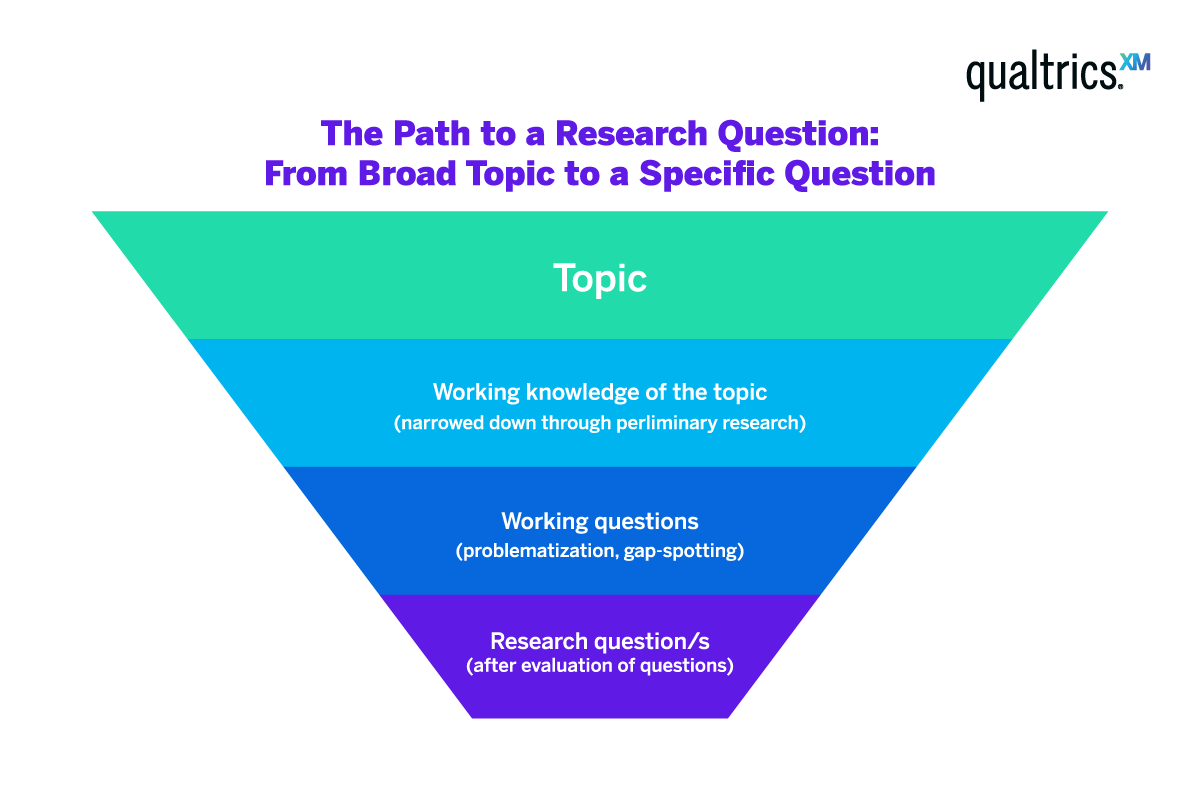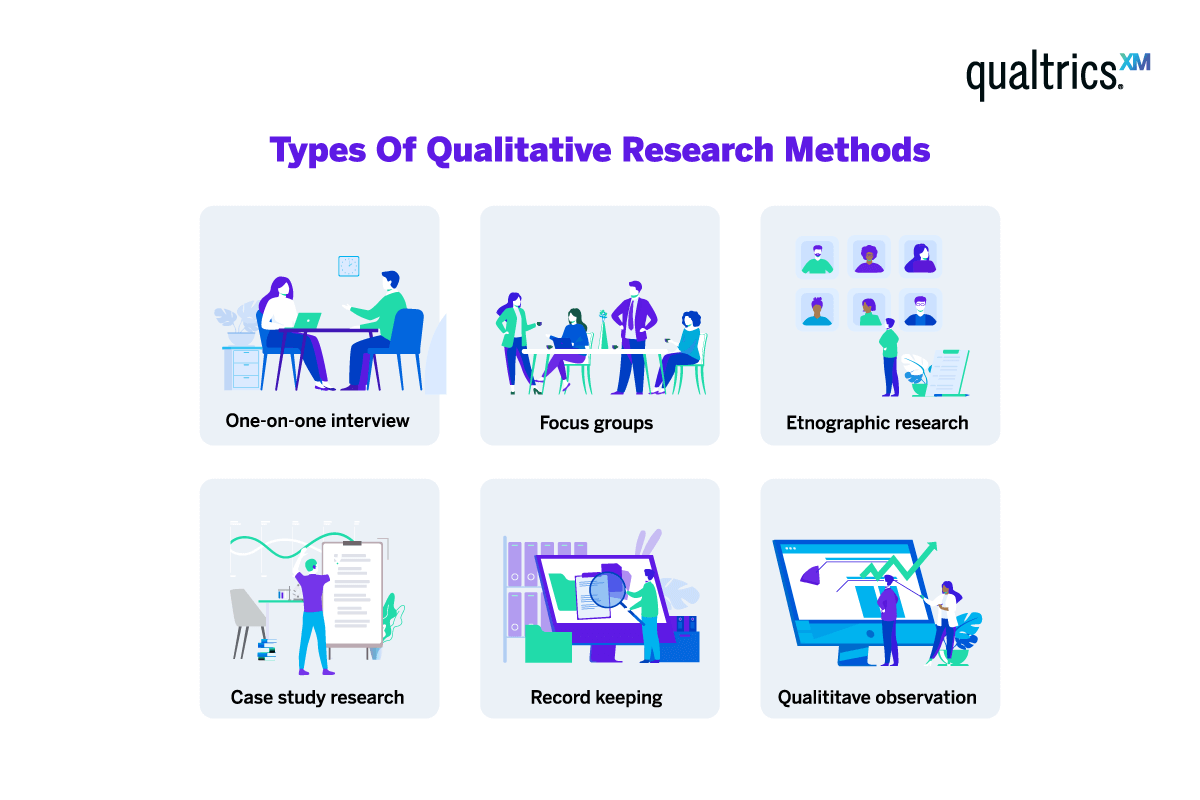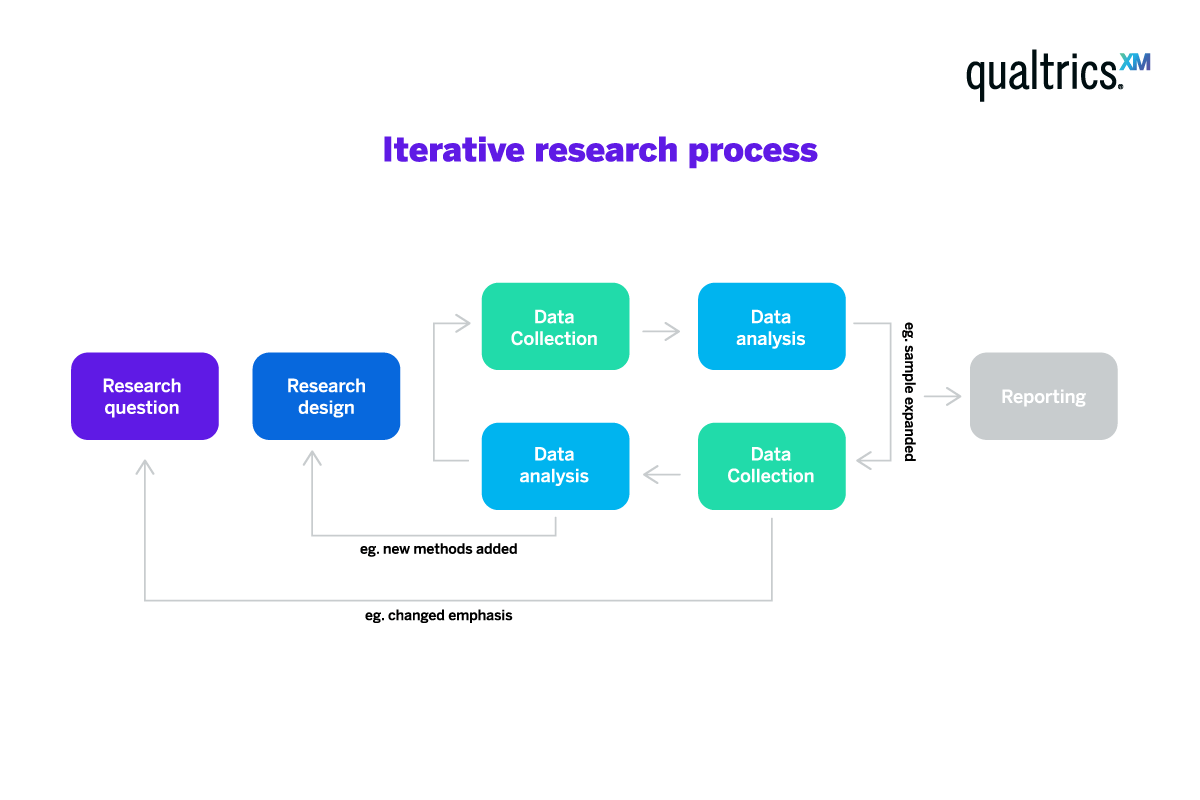Recap: qualitative research vs. quantitative research
If quantitative research is a drone capturing aerial footage, qualitative research is a portrait photographer studying a local neighbourhood.
- Qualitative research involves non-numerical data, most often related to social or personal topics. It may investigate people’s opinions, thoughts, feelings and preferences. Qualitative research often relies on a researcher’s first-hand interactions with research participants through techniques like focus groups and interviews. It tends to be deep and detailed, rather than broad and far-reaching.
- Quantitative research, on the other hand, deals with quantities, proportions and other countable data. Examples of quantitative research might be finding out the number of people in a city or the amount of income earned by a business in a year. In contrast, quantitative research methods are more likely to be large-scale and generalised, even abstract. It doesn’t tend to require direct contact between researchers and the populations they are studying.
Market research trends: the challenges and priorities for researchers around the world
What makes a great qualitative research study?
Qualitative research focuses on seeing, listening and understanding – as a researcher on behalf of a business, your goal is to capture not only the particulars of what is happening, but the deeper ‘why’ of consumer behaviours and opinions.
Accurate observation and recording are critical to the success of qualitative research, but without the right foundations laid in terms of your methods, you may end up with qualitative data that are of limited use.
Designing a great qualitative research program means paying as much attention to the design of your study and the choice of methods as actually performing data collection. Presenting your results well matters too. People remember stories, not figures, so qualitative data is a great way to bring your insights to life.
Although qualitative and quantitative studies differ in important ways, it’s worth remembering that your business question may benefit from both qualitative and quantitative research. For example, you might use qualitative research to uncover the attitudes and behaviors of your target audience, then use quantitative analysis to find out how widespread these phenomena are in your research population. Conversely, you might use qualitative analysis to provide the ‘why’ behind your quantitative data.
Online or offline?
Many traditional qualitative research methods involve direct contact between researcher and participant, but thanks to advances in technology, online methods are both effective and widespread. The emergence of COVID-19 in 2020 prompted a shift in the direction of online qualitative methods.
Establishing your research goals in qualitative research
As with any program of research, the first step is to define your aims. You and everyone working with you must have a clear, shared understanding of what your qualitative research program is trying to achieve.
Defining the research question
A research question sums up the overall goal of your qualitative research project. It identifies the information you’re trying to find through your research.
Examples of possible questions:
- ‘What is the effect of inflation on the purchasing behaviour of young people in America?’
- ‘How does access to social media affect the emotional development of children?’
- ‘How does climate change affect rural communities in South Sudan?’
Larger studies may have more than one research question. However, as the purpose is to narrow down the scope of your research into one explicitly defined area, don’t add extra research questions unless they’re required for a very complex research process.

Sampling and recruitment
To do qualitative research well, you need to know who you’re studying, and you need a reliable way to identify them. Going back to your research questions, think about who the population of interest is for your study. Who will your participants be as you carry out data collection? Will you use a conventional probability sampling method to find a random representative sample of the research population? Or is it more appropriate to use alternative methods, such as snowball sampling or quota sampling?
Qualitative approaches typically use smaller numbers of participants than quantitative research methods, studying smaller numbers of people in-depth rather than seeking out a broad consensus. That means your selection of participants becomes very important.
Note that while outliers in a research population can create anomalies in quantitative research, in qualitative research it is important to include them, as you’re looking to get a broad range of perspectives and opinions into your study.
Approaches to qualitative research
There are five core approaches to qualitative research:
1. Grounded theory
This is an exploratory approach where the researcher’s hypothesis emerges from their qualitative data as they collect it. Using inductive reasoning – where a theory is developed by generalising from a range of observations – researchers adapt their understanding of their research topic as they go along. Although grounded theory requires open-ended thinking, it’s quite structured. Researchers use a system of codes to link observations to overarching theories, eventually extrapolating these theories to even higher levels that result in deeper insights.
2. Ethnographic research
This approach involves studying people in the context of their normal environment. It may involve face-to-face interaction or indirect observations.
3. Action research
In action research, also called participatory action research (PAR), participants and researchers with a shared purpose are involved in a change process in a specific context and situation. The researcher learns about what kind of change is required through their own experiences and the reflections of the participants. This kind of qualitative research is more common in fields like healthcare and education.
4. Phenomenological research
Phenomenological research is the study of phenomena – events or states, often noteworthy or unusual ones, through the people who live through them. Phenomenological research focuses on people’s lived experiences and how their lives have influenced their beliefs and behaviours – in particular their response to the phenomena being studied. It deals with groups of people in shared contexts, such as women in the military, minorities in the workplace, asylum seekers in the education system and so on.
5. Narrative research
Also known as narrative enquiry, narrative research is a qualitative method that examines the way people tell their own stories. In particular, it looks at how people ascribe meaning to their experiences and how this influences their views and life choices. As well as interpersonal research using techniques like interviews and focus groups, narrative research can gather data from journals, autobiographies or letters.
Qualitative research methods

There are a broad range of qualitative research approaches, with new qualitative methods that take advantage of advances in communication technology. The COVID-19 pandemic has expedited the shift to online research, not only for asynchronous data collection such as document-based study, but in live interactive formats like video interviews and moderated Zoom groups.
However, some of the best-known types of qualitative study have stood the test of time regardless of world events. Here are some of the most popular ways to carry out qualitative research.
-
Interviews
Maybe the classic among data collection methods, in depth interviews allow the researcher to connect personally with the participants and gather data in a one-on-one session. As well as listening to the participant, the researcher can gain insights by observing body language, tone of voice and facial expression to gather information in greater detail. Open ended questions are used to encourage participants to express their perspectives and feelings in their own words.
-
Focus groups
Like qualitative interviews, focus groups provide in depth insights through personal communication and direct observations. They often take place in natural settings with the researcher acting as moderator for a small group discussion. Focus groups are a type of qualitative study best known for their market research application, but they can be used by qualitative researchers in a wide range of fields, such as health sciences, social research and social sciences.
-
Observational studies
This kind of qualitative study involves data collection without direct interaction between participant and researcher. Instead, qualitative data is drawn from direct observation of people, often in their natural settings. This gives the qualitative researchers less specific information on their thoughts and feelings, but may offer a better understanding of behaviours and relationships in specific contexts, such as a busy office, a clinic or a classroom.
-
Discussion boards
Online discussion boards allow researchers to study conversations on the topics they are interested in, as well as asking questions themselves. One benefit is that the wealth of discussion boards online offers data on almost every topic imaginable, since this format is one of the internet’s oldest, significantly pre-dating social media. Discussion board data can even be analysed at scale with the use of text mining.
Qualitative data analysis
Once the data collection phase is over, you’re ready to move on to the next stage of the research process – data analysis. Qualitative data analysis involves finding the patterns and trends in the data collected during your study. However, unlike a quantitative study with numerical data, it doesn’t come in a consistent format. That means your research team will need to spend a significant chunk of your project time on a careful analysis of the results, particularly if you’re working without specialist data analysis software.
1. Standardise your qualitative data
Unlike the data collection itself, this can be a systematic process where your field notes, literature review, participant observations and video recordings are transcribed so that everything is standardised in a written format that you can easily navigate and analyse. Software can be extremely valuable in turning handwritten notes, and even voice and video files, into text automatically.
2. Code and categorise
You can assign codes in qualitative data analysis to highlight where a particular topic is mentioned in your data so that it’s easier to find. Categorisation can also be useful, especially if you’re working with a number of other people who need to work on the findings. Using data analysis tools with semantic analysis and natural language processing can speed things up enormously, as this work is done for you automatically.
3. Find patterns and trends
With all of your data collected and categorised, it’s time to look at it as a whole and examine any patterns or trends that seem to emerge. Again, software that has the capacity to identify trends and relationships, even in natural language data, can be a valuable addition to your analysis process, especially as it will offer an impartial perspective to help you avoid any blind spots or bias arising from personal thoughts and feelings about the research topic.
4. Revisit your hypothesis
Finally, you can return to your research question with new knowledge. Are you closer to an answer? Was the question the right one, and would you ask the same one now given what you’ve learned? This may be a jumping-off point for further research into your findings, or the start of a whole new qualitative inquiry.
5. Report your findings

The quality of your reporting can make all the difference in terms of how effective your research data will be. When presenting your findings to stakeholders, use engaging formats and clear language to summarise your discoveries and to link them to business goals. Video highlight reels are a powerful way to bring insights to life, and can be used to bring the customer’s experience direct to stakeholders through personal stories and testimonials.
Market research trends: the challenges & priorities for researchers around the world